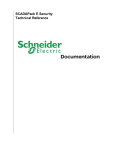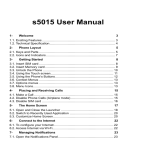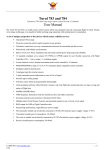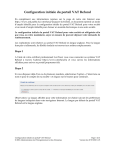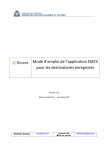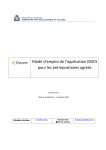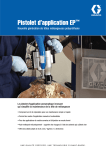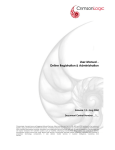Download USER Manual - Administration de l`Enregistrement et des Domaines
Transcript
USER MANUAL The VATMOSS portal allows users of a taxable person having access to the VATMOSS system to fulfil their tax obligations including the management of the registration data (registration request to the special scheme, updates of the registration data, exclusion request from the special scheme) and the filing of the VAT return. DOCUMENT HISTORY Version Date Author Description 1.00 29/09/2014 AED Initial Version USER Manual Page 1 on 36 VATMOSS Table of Contents 1. INTRODUCTION .......................................................................................... 8 1.1. OBJECTIVE ......................................................................................................... 8 1.2. STRUCTURE OF THE DOCUMENT ...................................................................... 8 2. CONNECTION .............................................................................................. 9 3. INITIAL REGISTRATION IN VATMOSS ......................................................... 10 3.1. REGISTRATION REQUEST................................................................................. 10 3.1.1. Union scheme ..................................................................................................... 11 3.1.2. Non-Union scheme ............................................................................................. 17 3.2. REQUEST SUBMISSION .................................................................................... 20 3.3. PROCESSING OF AN INITIAL REGISTRATION REQUEST .................................... 21 4. OTHER TYPES OF REQUESTS ...................................................................... 23 5. UPDATE OF THE REGISTRATION DATA ....................................................... 24 6. EXCLUSION REQUEST ................................................................................ 25 6.1. EXCLUSION FORM ........................................................................................... 25 6.1.1. Union scheme ..................................................................................................... 25 6.1.2. Non-Union Scheme............................................................................................. 27 6.2. UPDATE OF THE REGISTRATION DATA AFTER AN EXCLUSION ........................ 27 7. RE-REGISTRATION IN VATMOSS ................................................................ 28 8. REQUESTS HISTORY .................................................................................. 29 9. NOTIFICATIONS......................................................................................... 31 9.1. FILTER THE NOTIFICATIONS ............................................................................ 32 9.2. DISPLAY A NOTIFICATION................................................................................ 33 10. USER’S PREFERENCES .............................................................................. 34 USER Manual Page 2 on 36 VATMOSS LIST OF TABLES Table 1: Abbreviations and Acronyms ............................................................................................................... 4 LIST OF FIGURES Figure 1: Special scheme of M1SS ..................................................................................................................... 5 Figure 2 : M1SS organization at the Grand-Duchy of Luxembourg .................................................................... 6 Figure 3: Connection screen ............................................................................................................................. 9 Figure 4: Registration ...................................................................................................................................... 10 Figure 5: Registration not possible .................................................................................................................. 11 Figure 6: EU Registration request – part 1 ...................................................................................................... 12 Figure 7: EU Registration request – part 2 ...................................................................................................... 13 Figure 8: EU Registration request – part 3 ...................................................................................................... 13 Figure 9: EU Registration request – Add a fixed establishment ....................................................................... 14 Figure 10: EU Registration request – part 4 .................................................................................................... 15 Figure 11: Deletion of the draft and loading of the last submitted data ......................................................... 16 Figure 12: Non-EU Registration request – part 1............................................................................................. 17 Figure 13: Non-EU registration request - part 2 .............................................................................................. 18 Figure 14: Non-EU registration request – part 3 ............................................................................................. 19 Figure 15: Deletion of the draft and loading of the last submitted data ......................................................... 20 Figure 16: Registration request submitted ...................................................................................................... 20 Figure 17: E-mail address validated ................................................................................................................ 21 Figure 18: Welcome screen after the acceptance of the registration by the AED ........................................... 21 Figure 19: Registration request accepted ....................................................................................................... 23 Figure 20: Update the registration .................................................................................................................. 24 Figure 21: Voluntary exclusion from the Union scheme .................................................................................. 25 Figure 22: Confirmation of the exclusion request ........................................................................................... 26 Figure 23: Exclusion request ........................................................................................................................... 26 Figure 24: Voluntary exclusion from the non-Union scheme .......................................................................... 27 Figure 25: Button “Reregister” ........................................................................................................................ 28 Figure 26: Link to the requests history ............................................................................................................ 29 Figure 27: History of the status of the LU NETP in VATMOSS .......................................................................... 29 Figure 28: History of the requests of the LU NETP in VATMOSS ...................................................................... 30 Figure 29: Requests comparison ..................................................................................................................... 30 Figure 30: List of notifications ......................................................................................................................... 31 Figure 31: Filter on the notifications ............................................................................................................... 32 Figure 32: Details of a notification .................................................................................................................. 33 Figure 33: User’s preferences ......................................................................................................................... 34 USER Manual Page 3 on 36 VATMOSS ABBREVIATIONS The following table shows the abbreviations used in this manual. For a detailed explanation of some concepts, the user can refer to the section “Definitions”. Abbreviation Meaning CTIE Centre des Technologies de l’Information de l’Etat AED Administration de l’enregistrement et des domaines M1SS Mini One Stop Shop Member State Member State of the European Union VATMOSS Luxembourgish M1SS MSID Member State of Identification in M1SS MSCON Member State of consumption NETP Non-Established Taxable Person LU NETP NETP being registered or registered in VATMOSS Special scheme Collective term to designate the Union scheme and the non-Union scheme EU LU NETP LU NETP registered in the Union scheme of VATMOSS Non-EU LU NETP LU NETP registered in the non-Union scheme of VATMOSS Quarantine Period after the exclusion of a NETP during which he cannot register to M1SS Notification Message addressed to the LU NETP by VATMOSS on the webportal VAT identification number Number allocated during the registration of a person to the VAT. It consists of an identical and unique group of 8 digits preceded by the two letters LU. This number is used in intra Community exchanges. Tax reference number Number that allows identifying the taxpayer in order to facilitate the tax administrations in their internal tax business. This number also allows the identification of taxpayers investing in other Member States. Table 1: Abbreviations and Acronyms DEFINITIONS A. The special scheme of Mini One Stop Shop M1SS The Mini One Stop Shop (M1SS) is an optional special scheme applicable to the telecommunications, broadcasting or electronic services supplied by taxable persons (NonEstablished Taxable Person) established or not in the European Union to non-taxable persons having their home or habitual residence within the territory of the European Union. The special scheme mainly aims to simplify administrative procedures of the NETP by allowing them to file and pay their VAT returns to only one Member State, called Member State of identification (MSID) [art. 358a, 369a DIR06/112], rather than having to complete procedures in each Member State in which they have provided services. On these returns, the NETP summarizes all the services provided to non-taxable persons in Member States, called Member States of consumption [art. 58 DIR06/112], where they are not located or where they do not have fixed establishments. USER Manual Page 4 on 36 VATMOSS Union scheme Non-Union scheme Figure 1: Special scheme of M1SS NETP There are two distinct sets of NETP that are likely to take advantage of this special scheme in a MSID: NETP tied to non-Union scheme: Any taxable person who has not established his business within the European Union, does not have a fixed establishment there, and is not obliged to register for VAT purposes may opt for the non-Union scheme as provided for in Section 2 of Chapter 6 of Title XII of DIR06/112. The taxable person can choose any Member Stare to be his Member State of identification. The MSID selected by the NETP identifies that NETP in M1SS through the allocation of an individual VAT identification number, called VoeS number, that meets the alphanumeric syntax EUxxxyyyyyz [art. 362 DIR06/112], where xxx is a digital code identifying uniquely the MSID, while yyyyy are 5 digits identifying uniquely the NETP and z is a check digit. NETP tied to Union scheme: Any taxable person who has established his business within the European Union or has at least a fixed establishment there may opt for the Union scheme as provided for in Section 3 of Chapter 6 of Title XII of DIR06/112. When the taxable person has established his business within the European Union, the Member State in which he has established his business is considered as MSID. When the taxable person has established his business outside the European Union, but has several fixed establishments in the Member States within the European Union, he is entitled to choose one of those Member States to be the Member State of identification. Please note that the “Union scheme” does not apply to telecommunications, broadcasting or electronic services supplied in a Member State where the taxable person has established his business or in which he has a fixed establishment. These supplies must be reported to the competent tax authorities of that Member State in the VAT return designated by the article 250 of DIR06/112. The identification of a NETP tied to the Union scheme in the optional scheme of M1SS is done through the VAT identification number that has been allocated by the MSID for its internal operations [art. 369d DIR06/112]. Thus a taxable person can only opt for the Union scheme if he is already registered for VAT purposes in the MSID. USER Manual Page 5 on 36 VATMOSS Luxembourgish M1SS (VATMOSS) Union scheme Non-Union scheme EU LU Non-EU LU NETP LU NETP Figure 2 : M1SS organization at the Grand-Duchy of Luxembourg B. The actors of the M1SS special scheme – The NETP The above chart shows that NETP’s are divided in two groups: LU NETP registered in the Luxembourgish M1SS, called VATMOSS and amongst which there are 2 kinds of scheme (Union and non-Union) ; Non LU NETP registered in M1SS in another Member State. EU LU NETP An EU LU NETP is a NETP registered in VATMOSS under the Union scheme, i.e. a NETP with its place of business or a fixed establishment in Luxembourg. The identification is done by the VAT identification number in Luxembourg. Non-EU LU NETP A non-EU LU NETP is a NETP registered in VATMOSS under the non-Union scheme, i.e. a NETP who chose Luxembourg as MSID. C. Related concepts MSID – Member State of identification (Union scheme and non-Union scheme) The Member State of identification is the Member State in which the NETP is registered to M1SS and performs his tax obligations including the filing of VAT returns and the payment of the due tax [art. 358a, 369a DIR06/112]. MSCON – Member State of consumption (Union scheme and non-Union scheme) The Member State of consumption is the Member State in which, based on the article 58 of DIR06/112, the supply of the telecommunications, broadcasting or electronic services is deemed to take place. USER Manual Page 6 on 36 VATMOSS Fixed establishment (Union scheme) A fixed establishment is any establishment, other than the place of business, that has a sufficient degree of permanence and a suitable structure in terms of human and technical resources in order to supply the services he delivers. Simply having a VAT Identification number does not in itself mean that an establishment qualifies as a fixed establishment. MSEST – Member State holding a fixed establishment (Union scheme) It is the Member State of the European Union in which there is a fixed establishment having provided services applicable to M1SS. USER Manual Page 7 on 36 VATMOSS 1. INTRODUCTION 1.1. OBJECTIVE The VATMOSS portal allows users of a LU NETP having access to the VATMOSS system to fulfil their tax obligations including the management of the registration data (registration request to the special scheme, updates of the registration data, exclusion request from the special scheme) and the filing of the VAT return. This document is the user manual of the VATMOSS portal. As it stands, it sets out how to connect to the portal, how to view notifications generated by VATMOSS or by the Administration de l’enregistrement et des domaines (AED) and how to handle the preferences that the user can adapt to his needs. 1.2. STRUCTURE OF THE DOCUMENT The document is composed of the following elements: Chapter 1 – Introduction gives an overview of the objective and the scope of this document and the intended audience ; Chapter 2 – Connection describes the procedure allowing a user to access to the portal ; Chapter 3 – Initial registration in VATMOSS describes how to register in VATMOSS ; Chapter 4 – Other types of Requests describes the requests that a NETP can submit in VATMOSS ; Chapter 5 – Update of the registration data describes how to update the registration data ; Chapter 6 – Exclusion Request describes how the NETP can proceed with its voluntary exclusion from VATMOSS ; Chapter 7 – Re-registration in VATMOSS describes how a NETP who has been excluded from VATMOSS can request his re-registration ; Chapter 8 – Requests history describes where the NETP can consult the history of the requests he submitted ; Chapter 9 – Notifications presents the follow-up of the received notifications ; Chapter 10 – User’s preferences describes how the user can modify his preferences. USER Manual Page 8 on 36 VATMOSS 2. CONNECTION The user of the portal, that is to say the LU NETP, must pass through the connection screen of the CTIE before accessing any page of the portal. The connection requires an active LuxTrust card and the necessary software to read the LuxTrust card installed on the client computer. The URL of the application in the production environment is: https://vatmoss.b2g.etat.lu/enoss-netp/ Figure 3: Connection screen USER Manual Page 9 on 36 VATMOSS 3. INITIAL REGISTRATION IN VATMOSS At the first connection to VATMOSS, the following welcome screen is displayed: Figure 4: Registration Before using VATMOSS, it is mandatory to submit a registration request. This is why the welcome screen displays a link to a registration form at the first connection. The current section describes the different steps that a LU NETP must perform in order to submit its registration request in VATMOSS. He must refer to: section “3.1.1 - Union scheme” for the EU LU NETP tied to the Union scheme ; section “3.1.2 - Non-Union scheme” for the non EU LU NETP tied to the non-Union scheme. Once the registration request is accepted by the AED, the LU NETP can access all the features of the web portal. 3.1. REGISTRATION REQUEST The LU NETP reaches the registration form by clicking on the button “Register my company”. The information that the LU NETP must provide is different depending on the scheme, i.e. Union scheme or non-Union scheme. The scheme applicable to the NETP will automatically be determined by VATMOSS. Before finally submitting a registration request, the LU NETP can save it as “draft”. Saving a draft can only be performed if the entered data is complete and valid. All the fields of the figures presented in the current section marked by a red asterisk must be filled in in order to submit the registration request to AED. USER Manual Page 10 on 36 VATMOSS 3.1.1. Union scheme 3.1.1.1. Prior checks (EU LU NETP) Before a registration request for a EU LU NETP can be submitted, VATMOSS checks if the EU LU NETP is a taxable person who is active and known to the national register of VAT identification. If it is not the case, an error message (Figure 5: Registration not possible) displays and informs the EU LU NETP that it will not be possible to submit a registration request and that he should contact the VATMOSS Support. Figure 5: Registration not possible If the EU LU NETP is a taxable person active and known by the database of AED, it is possible to fill in a registration request in VATMOSS. For the Union scheme, some fields of the registration request in the following figure are initialized via the data coming from the national register of VAT identification. It is the gray fields in the “Figure 6: EU Registration request – part 1”. If these pre-initialized fields are incorrect, the EU LU NETP must contact the VATMOSS Support before being able to proceed. Here is the screen used to perform a registration request to VATMOSS for the Union scheme: USER Manual Page 11 on 36 VATMOSS 1 2 Figure 6: EU Registration request – part 1 ① Change of Member State of identification: This frame must be filled in if the EU LU NETP was registered for the Union scheme in another Member State in the European Union and that he requested to be excluded from this Member State with the intent to register for VATMOSS in Luxembourg. In the case of a change of MSID, the EU LU NETP must tick the box “Yes” and indicate his previous MSID as well as the VAT identification number in this Member State. ② Identification detail: The Individual VAT identification number, the company name, and the address are pre-initialized and not modifiable fields (greyed fields on the above figure). About the address, it is the address of the place of business in Luxembourg or, failing that, the address of the fixed establishment in Luxembourg coming from the national register of VAT identification ; The box called “The country in which the taxable person has his place of business” informs the country in which the place of business of the EU LU NETP is. It is either the Grand Duchy of Luxembourg or, if there is no place of business within the European Union, the country outside the European Union where the place of business of the company is ; A first button “Add” allows to add one or several trading name(s) if this or these ones differ from the company name ; USER Manual Page 12 on 36 VATMOSS A valid e-mail address must be specified in order to continue the registration and finalize it. Indeed, this e-mail address will be checked by the sending of an e-mail from VATMOSS before the finalization of the registration process. By ticking the underneath box, the EU LU NETP can force the sending of an e-mail to this address whenever a notification is addressed to him on the portal ; A second button “Add” allows to add several websites to the company ; 3 4 5 Figure 7: EU Registration request – part 2 ③ Services: Gives the details about the types of services that the EU LU NETP provides. The relevant boxes should be ticked and a description of the provided services must be given. ④ Contact: This part of the registration request includes the information about the contact person at the EU LU NETP for the AED. If the national register of VAT identification holds a phone number, this phone number is pre-initialized, but may be modified. ⑤ Bank Account: Includes the bank details of the EU LU NETP that are pre-initialized with data coming from the national register of VAT identification. The pre-initialized data may still be modified. 6 7 8 Figure 8: EU Registration request – part 3 ⑥ Fixed establishments located in a Member State other than the MSID: A fixed establishment is any establishment, other than the place of business, that has a USER Manual Page 13 on 36 VATMOSS sufficient degree of permanence and a suitable structure in terms of human and technical resources in order to supply the services it delivers. Simply having a VAT Identification number does not in itself mean that an establishment qualifies as a fixed establishment. All fixed establishments that the EU LU NETP company has on the territory of the European Union must be specified. ⑦ It is possible to remove a fixed establishment that is already filled via the cross on the right. The removal is taken into account when the registration is saved as “draft” or submitted. ⑧ It is possible to add a fixed establishment by clicking on the button “add a fixed establishment”. The opening pop-up allows the user to enter the information related to the fixed establishment. 10 9 11 12 Figure 9: EU Registration request – Add a fixed establishment ⑨ Information related to the identification of the fixed establishment. ⑩ Address of the fixed establishment. ⑪ This button allows one to confirm the addition of a fixed establishment to the existing list. The addition of a fixed establishment does not save the changes done to the registration request. In order to save these changes, it is needed to save the registration request by clicking on the button ⑰ on the following figure. ⑫ This button allows one to cancel the modifications that have been done until now on the fixed establishment. USER Manual Page 14 on 36 VATMOSS 13 14 15 16 17 18 Figure 10: EU Registration request – part 4 ⑬ VAT identification number(s) allocated by Member State(s) as a non-established taxable person: This part lists the identification numbers that the taxable person has in others Member States. In this case, they are Member States in which the EU LU NETP has neither a place of business, nor a fixed establishment, but in which he is obliged to register for VAT purposes, particularly for distance sales. ⑭ Date of commencement of using the scheme: It is the beginning date of the activities covered by the Union scheme. By default, the first box is ticked: in this case, the beginning date of the activities covered by VATMOSS is the first day of the calendar quarter following the one during which the EU LU NETP submitted the registration request in VATMOSS, provided that the registration request has been accepted and validated by the AED during the quarter of application to join the Union scheme. The legislation allows one to force a beginning date based on the date of first supply of services [art. 57d of Council regulation (EU) No 967/2012 of 9 October 2012]. In this case, the registration request must be done at the latest the tenth day of the month following the date of the first service supplied. By ticking the second box, the user can only enter a date between the date of the first supply of service and the tenth day of the month following the first supply of services. ⑮ Previous use of either of the special schemes: By ticking the box “Yes”, this section must list all the previous registrations of the LU NETP to M1SS, whether in the Union or the non-Union scheme, in Luxembourg or any other Member State. ⑯ Submit: Validates the request before submitting it (see the section “3.2 - Request submission”). The validation of the e-mail address provided by the EU LU NETP in the registration request is needed before definitive submission of the registration request for acceptance by the AED. USER Manual Page 15 on 36 VATMOSS ⑰ Save as draft: Validates the request before saving it as draft. The EU LU NETP can continue filling the form later. ⑱ Cancel: Cancels the unsaved changes. When the EU LU NETP saved a registration request as “draft” for the Union scheme or in case of rejection for any reason whatsoever of a first registration request by the AED, the EU LU NETP can access to the draft at the next connection to VATMOSS or load the last registration request submitted to AED by clicking on the tab “Registration data”. 19 20 Figure 11: Deletion of the draft and loading of the last submitted data ⑲ Delete the draft: Definitively deletes the current draft and loads the last data validated by the AED. If any registration request has been validated by the AED, the page goes back to its initial state at the page 10 on “Figure 4: Registration”. ⑳ Show the last transmitted registration: After the submission of a registration request, the AED can reject it and the EU LU NETP has the possibility to cancel it as long as an AED agent is not in charge of the request. This button allows one to reload the last data submitted to the AED (whatever the status: accepted, rejected or cancelled). If a draft exists, it is not overwritten. For that, it is needed to save the request. USER Manual Page 16 on 36 VATMOSS 3.1.2. Non-Union scheme In the case of the non-Union scheme, the input screen of a registration request stands as follows: 1 Figure 12: Non-EU Registration request – part 1 ① Identification detail: Company details: The individual VAT identification number cannot be entered. This grayed field will be empty in the case of a registration or a re-registration request for the non-Union scheme. In the case of an update of the registration data, the field will be pre-initialized (see section “5 - Update of the registration data”) ; The first button “Add” allows one to add one or several trading name(s) if they differ from the company name ; The box called “The country in which the taxable person has his place of business” must be filled with the country of the place of business of the non-EU LU NETP. It is the country where the place of business is. The non-EU LU NETP also fills the national tax number in this country (“National tax number”) ; USER Manual Page 17 on 36 VATMOSS Address: The address must be filled carefully. It is the address of the place of business of the non-EU LU NETP located outside of the European Union ; A valid e-mail address must be specified in order to continue the registration and finalize it. Indeed, this e-mail address will be checked by the sending of an e-mail from VATMOSS before the finalization of the registration process. By ticking the underneath box, the non-EU LU NETP can force the sending of an e-mail to this address whenever a notification is addressed to him on the VATMOSS portal A second button “Add” allows one to add several web sites to the company ; 2 3 4 Figure 13: Non-EU registration request - part 2 ② Services: Gives the detail about the type of services provided by the non-EU LU NETP. The relevant boxes should be ticked and a description of the provided services must be given. ③ Contact: This part of the registration request includes the information about the contact person at the non-EU LU NETP for the AED. ④ Bank Account: Includes the bank details of the non-EU LU NETP to be filled as an IBAN or, if not available, an OBAN. USER Manual Page 18 on 36 VATMOSS 5 6 7 8 9 10 Figure 14: Non-EU registration request – part 3 ⑤ Date of commencement of using the scheme: It is the beginning date of the activities covered by the non-Union scheme. By default, the first box is ticked: in this case, the beginning date of the activities covered by VATMOSS is the first day of the calendar quarter following the one during which the non-EU LU NETP submitted the registration request in VATMOSS, provided that the registration request has been accepted and validated by the AED during the quarter of application to join the non-Union scheme. The legislation allows one to force a beginning date based on the date of first supply of services [art. 57d of Council regulation (EU) No 967/2012 of 9 October 2012]. In this case, the registration request must be done at the latest the tenth day of the month following the date of the first service supplied. By ticking the second box, the user can only enter a date between the date of the first supply of service and the tenth day of the month following the first supply of services. ⑥ Previous use of either of the special schemes: By ticking the box “Yes”, this section must list all the previous registrations of the LU NETP to M1SS, whether in the Union or the non-Union scheme, in Luxembourg or any other Member State. ⑦ Electronic declaration: before saving the request as draft or submitting it, the nonEU LU NETP must certify that he is not registered for VAT in a Member State. ⑧ Submit: Validates the request before submitting it (see the section “3.2 - Request submission”). The validation of the e-mail address provided by the non-EU LU NETP in the registration request is needed before the definitive submission of the registration request for acceptance by AED. ⑨ Save as draft: Validates the request before saving it as draft. The non-EU LU NETP can continue filling the form later. ⑩ Cancel: Cancels the unsaved changes. When the non-EU LU NETP saved a registration request as “draft” for the non-Union scheme or in case of rejection for any reason whatsoever of a first registration request by the AED, the non-EU LU NETP can access to the draft at the next connection to USER Manual Page 19 on 36 VATMOSS VATMOSS or load the last registration request submitted to AED by clicking on the tab “Registration data”. 11 12 Figure 15: Deletion of the draft and loading of the last submitted data ⑪ Delete the draft: Definitively deletes the current draft and loads the last data validated by the AED. If any registration request has been validated by AED, the page goes back to its initial stage at page 10 on the “Figure 4: Registration”. ⑫ Show the last transmitted registration: After the submission of a registration request, the AED can reject it and the non-EU LU NETP has the possibility to cancel it as long as an AED agent is not in charge of the request. This button allows one to reload the last data submitted to the AED (whatever the status: accepted, rejected or cancelled). If a draft exists, it is not overwritten. For that, it is needed to save the request. 3.2. REQUEST SUBMISSION After having completed the registration request form, the LU NETP can submit it by clicking on the button “Submit” shown in the “Figure 10: EU Registration request – part 4” in the case of EU LU NETP tied to the Union scheme or in the “Figure 14: Non-EU registration request – part 3” in the case of non-EU LU NETP tied to the non-Union scheme. The submission of the request is followed by a notification (see the section “9 - Notifications”). Figure 16: Registration request submitted In the case of the submission of an initial registration request dealt in section “3.1 Registration request“, the LU NETP has to validate within 24 hours the e-mail address provided in the registration request form. If the LU NETP does not validate the e-mail USER Manual Page 20 on 36 VATMOSS address within 24 hours, the registration request is automatically rejected by VATMOSS and the LU NETP will have to submit a new registration request. The validation of the email address of the LU NETP is done through a link sent to the LU NETP and on which it must click. The validation of his registration request is going on. It is still possible for the NETP to cancel his registration request at this step, as long as the registration request is not being processed by an AED agent. Figure 17: E-mail address validated 3.3. PROCESSING OF AN INITIAL REGISTRATION REQUEST A registration request submitted to the AED can be either accepted or rejected. In both scenarios, a notification will be addressed to the LU NETP on the portal (see the section “9 - Notifications”). If the registration request is rejected by the AED, the initial form is displayed during the access to the menu “Registration data”. In case of acceptance of the registration, the welcome screen of VATMOSS stands as follows during the subsequent connections to the portal: Figure 18: Welcome screen after the acceptance of the registration by the AED USER Manual Page 21 on 36 VATMOSS A summary of the registration data of the LU NETP company is shown in the left part of the screen, whereas the right part lists the last information of the VAT returns submitted by the NETP (as from 1 January 2015). In the lower part of the screen are the unread notifications of the LU NETP. USER Manual Page 22 on 36 VATMOSS 4. OTHER TYPES OF REQUESTS Once registered in VATMOSS, the tab “Registration data” displays the registration form initially submitted by the LU NETP, but the form is read-only and now corresponds to the registration data of the LU NETP. During his registration to the special scheme, either the Union or the non-Union scheme, a LU NETP can be required to update his registration data or to request his exclusion from the special scheme. This LU NETP can also be excluded from the special scheme by the AED. The screen “Registration data” of the following figure allows one to display the different types and statuses of a request (draft, submitted data, validated data) that the LU NETP can possibly submit: 1 2 19 19 Figure 19: Registration request accepted ① Update the registration data: A click on the button allows the LU NETP to fill in an update request for his registration data (see the section “5 - Update of the registration data”) ; ② Request an exclusion: This button will lead the LU NETP to a form that allows him to request his exclusion from a special scheme (see the section “6.1 - Exclusion form”). USER Manual Page 23 on 36 VATMOSS 5. UPDATE OF THE REGISTRATION DATA Once registered, the LU NETP can perform an update of his registration data by clicking on the button “Update the registration data” (Figure 19: Registration request accepted). The LU NETP is guided through the following screen that allows him to load the last registration data submitted to the AED. It displays the same form as the initial registration request (see the section “3.1 - Registration request”). However, the form is pre-initialized with the last registration data submitted in edition mode. Nevertheless, it is not possible to change the date of commencement of using the scheme. There is no restriction on the number of submissions of registration updates even without the validation of the previous request. Figure 20: Update the registration The same way as for an initial registration request, it is possible to save a new draft, to delete it or to load the last submitted data (whatever their status: accepted, rejected or cancelled). Please note that there is no limit on the number of registration request updates simultaneously submitted. If an update request is cancelled by the LU NETP, it is the previous update that is displayed or the last request accepted by the AED in case there is no other pending update. USER Manual Page 24 on 36 VATMOSS 6. EXCLUSION REQUEST A LU NETP registered in VATMOSS can ask his own exclusion from VATMOSS. A click on the button “Request an exclusion” from the screen “Registration Data” shown on the “Figure 19: Registration request accepted“ leads to the exclusion request form. The procedure of an exclusion request for a: EU LU NETP tied to the Union scheme is described in the section “6.1.1. - Union scheme“ ; Non-EU LU NETP tied to the non-Union scheme is described in the section “6.1.2. Non-Union Scheme”. 6.1. EXCLUSION FORM 6.1.1. Union scheme The exclusion request form for the Union scheme is as follows: 2 1 Figure 21: Voluntary exclusion from the Union scheme The EU LU NETP can invoke several reasons to justify the submission of an exclusion request to the AED: “I no longer supply telecommunications, broadcasting or electronic services”. This choice involves a quarantine period of two calendar quarters from the date of cessation ; “My business no longer has a fixed establishment in the European Union and I want to make immediately use the special scheme for telecommunications, broadcasting services or electronic services supplied by taxable persons not established within the European Union”. This choice does not involve a quarantine period. The EU LU NETP must inform the date at which he has ceased to have a fixed establishment in the European Union ; “I request to be identified in another Member State”. This choice does not involve a quarantine period, but asks to point out the change reason: o “Because my business is not established in the European Union and I wish to make use of the special scheme covering telecommunications, broadcasting USER Manual Page 25 on 36 VATMOSS and electronically supplied services in another Member State in which I have a fixed establishment. Furthermore I am registered to the special scheme with the administration of Luxembourg for two years at least”. In this case, the EU LU NETP is invited to inform about the other Member State and the VAT identification number ; o “Because my business is not establishment in the European Union and I have ceased to have a fixed establishment in Luxembourg. I still want to use hereafter the special scheme by registering in another Member State in which I have a fixed establishment”. The EU LU NETP must inform the date from which he has ceased to have a fixed establishment in Luxembourg, and is invited to provide the other Member State and the VAT identification number ; o “Because my place of business is located in the European Union and I have moved my place of establishment from your country to another Member State”. The EU LU NETP must inform the date from which he has ceased to have a fixed establishment in Luxembourg, the other Member State and the VAT identification number ; “Other reason”. This choice involves a quarantine period of two calendar quarters from the date of cessation. Clicking on “Request exclusion” ① opens a confirmation pop-up shown on the following figure to ensure that the exclusion is intended. It is also possible to “Cancel” ② the action if the EU LU NETP does not want to be excluded. Figure 22: Confirmation of the exclusion request After the confirmation of the exclusion request, this one is submitted to the AED and a notification on the following figure points out the sending of the request on the VATMOSS portal. After the submission of a registration request and before the acceptance by the AED, the EU LU NETP can update his registration data ③: Figure 23: Exclusion request For the update of the registration data after an exclusion of VATMOSS, it is referred in the section “6.2. - Update of the registration data after an exclusion”. USER Manual Page 26 on 36 VATMOSS 6.1.2. Non-Union Scheme The exclusion request form from the non-Union scheme is as follows: Figure 24: Voluntary exclusion from the non-Union scheme The non-EU LU NETP can invoke several reasons to justify the submission of an exclusion request to the AED: “I no longer supply telecommunications, broadcasting or electronic services“. This choice involves a quarantine period of two calendar quarters from the date of cessation ; “My business has opened a fixed establishment in the European Union and I want to make immediately use of the special scheme for telecommunications, broadcasting services or electronic services supplied by taxable persons established within the European Union but not established in the Member State of consumption”. This choice does not involve a quarantine period. The non-EU LU NETP must inform the date from which he has opened a fixed establishment in the European Union and the other Member State and the VAT identification number ; “Other reason”. This choice involves a quarantine period of two calendar quarters from the date of cessation. For the finalization of the exclusion request process, it is referred in the procedure described in the previous section about the exclusion of the Union scheme. 6.2. UPDATE OF THE REGISTRATION DATA AFTER AN EXCLUSI ON After the LU NETP has been excluded from VATMOSS, the latter can always update part of his registration data. Clicking on the button “Update the registration data” on the screen “Registration data” (shown on the “Figure 23: Exclusion request”) displays the registration request form (see the section “3.1 - Registration request”) by limiting the edition of the following fields: E-mail address ; Contact ; Bank Account. USER Manual Page 27 on 36 VATMOSS 7. RE-REGISTRATION IN VATMOSS A LU NETP excluded from VATMOSS and whose period of quarantine has expired (in the case where such a period is expected by the laws in force) can ask its re-registration. If an excluded LU NETP wants to be re-registered, it must connect to VATMOSS and click on the button “Reregister” ① from the tab “Registration data“: a registration form similar to the one described on the section “3.1 - Registration request” will be displayed, section to which it is referred for the submission procedure of the form. 1 Figure 25: Button “Reregister” After the submission of an eventual registration request, it is checked if there is not any quarantine period imposed on LU NETP by another Member State (after 1 January 2015). USER Manual Page 28 on 36 VATMOSS 8. REQUESTS HISTORY It is possible to access to the “View requests history” ① from the “Registration data” screen shown on the “Figure 19: Registration request accepted“ in the case of an active LU NETP and on the following figure on the case of an excluded LU NETP. 1 Figure 26: Link to the requests history This link allows one to consult the history of the LU NETP status, meaning registered or excluded, in VATMOSS: 3 2 Figure 27: History of the status of the LU NETP in VATMOSS The LU NETP can: ② Display all the requests of the LU NETP by clicking on “Display requests”. The LU NETP is sent to the following screen including the set of requests submitted by the LU NETP. It may be registration, exclusion or re-registration requests. ③ Sort the requests in reverse chronological order. USER Manual Page 29 on 36 VATMOSS 4 Figure 28: History of the requests of the LU NETP in VATMOSS The above screen allows one to display the detail of an update (in read-only mode) by clicking on the link ④. In the case of an update request displayed in this history, it will be compared to the last validated version of the registration data: Figure 29: Requests comparison USER Manual Page 30 on 36 VATMOSS 9. NOTIFICATIONS A notification is the way used by VATMOSS (or the AED in case of manual notification) in order to communicate with the LU NETP the fact that an event happened or an action on his side is required. The notifications requiring an action from the user are called “persistent notifications”. They can be considered as “read” only when the required action has been performed by the LU NETP and validated by the AED. The list of the notifications received by the NETP is available by clicking on the tab “Notifications” in the main menu. The wording of the menu is followed by a red dot indicating the number of unread notifications. The following screen is then displayed: 1 2 3 5 4 Figure 30: List of notifications By default, no filter is applied: the list of notifications includes all notifications received by the LU NETP. The first column is displayed only for persistent notifications and can include the following value when a notification requires the execution of an action by the LU NETP and that action has not yet been performed. From this screen several actions are possible: ① Filter the list of the notifications (see the section “9.1 - Filter the notifications”); ② Change the sorting order of the table. By default, the notifications are sorted according to their issuing date, newest first. USER Manual Page 31 on 36 VATMOSS By clicking on the header of a column, it is possible to sort the table according to that column: a click sorts according to an ascending order, a second click sorts according to a descending order. The sort on a column deletes any other sort previously applied. ③ Display the details of a notification by clicking on the corresponding line in the table (see the section “9.2 - Display a notification”). ④ Display more or less elements in the table. The user can choose to display 10, 50 or 100 elements per page. ⑤ Browse between the pages of results. 9.1. FILTER THE NOTIFICAT IONS To filter the list of notifications, the user just has to click on the icon the filter currently applied. The following form is then displayed: 8 1 2 3 in order to display 4 5 6 7 Figure 31: Filter on the notifications The information displayed in the fields ① to ⑤ corresponds to the filter currently applied (none by default). It is possible to change the filtering by modifying the content of the fields ① to ⑤ according to the desired information: The fields “from” ① to “to” ② allow one to define a period during which the notifications to list must have been sent: If both fields are specified, the listed notifications must have been sent from the date “from”, and until the date “to” (included) ; If only the field “from” is specified, the notifications must have been sent from that date ; If only the field “to” is specified, the notification must have been sent until this date ; If no fields are specified, no restrictions will be applied to the date at which the listed notifications have been sent. ③ The field “Notification type” allows one to select the type of notification to display on the list. If no type is selected, no restriction will be applied on the types to display. It is not possible to select several types of notifications through this field. ④ The field “Free subject of the notification” allows one to limit the list of the notifications to those having a subject manually entered by the user that include the indicated text. ⑤ The field “Only unread notifications” allows, when the box is ticked, to display only the notifications that have not been read. USER Manual Page 32 on 36 VATMOSS ⑥ Click on the button “Filter” in order to apply the filter that has been defined. All these criteria can be cumulated: only the notifications in accordance with the all the criteria will be listed. The user can also: ⑦ Reset the filter to its default value by clicking on the button “Reset”. ⑧ Hide the detail of the filter by clicking on the button any impact on the filter being applied. . This action does not have 9.2. DISPLAY A NOTIFICATION After clicking on a notification, the following screen describes the information about the notification: 1 2 Figure 32: Details of a notification The user can do the following actions: ① Export the PDF associated to the notification by clicking on the icon corresponding to the selected language. ② Browse among the notifications displayed in the list of notifications: allows one to move to the previous notification in the list ; allows one to go back to list ; allows one to move to the next notification in the list. Note : The filter that has been applied is saved as long as the user does not disconnect or apply another filter. The browsing in the list is done with respect to this filter. USER Manual Page 33 on 36 VATMOSS 10. USER’S PREFERENCES Each user of a LU NETP can customize the behavior of the portal via the preferences of the user. To access to the screen of preferences modification, the user clicks in the main menu on the choice “Preferences” (the gearwheel). The following screen is then presented: 1 2 3 4 5 Figure 33: User’s preferences From this screen, several actions are possible: ① Change the language of the portal by default. This language will be used after each connection and it will always be possible to change the language by using the corresponding link in the header of the portal. ② Change the e-mail address. The displayed e-mail address comes initially from that linked with the LuxTrust card (if the e-mail address is entered). The user can modify the e-mail address. ③ Ask to receive an e-mail when a new notification is available on the portal. It is then mandatory to enter the e-mail address to use. ④ Save the modifications. The language by default will be used at the next connection and the warning by e-mail will be taken into account during the sending of the next notification. ⑤ Cancel the modifications. The previous value will then be restored. USER Manual Page 34 on 36 VATMOSS Administration de l’enregistrement et des domaines 1-3 avenue Guillaume L-1651 Luxembourg Adresse postale : BP 31 L-2010 Luxembourg [email protected]






































